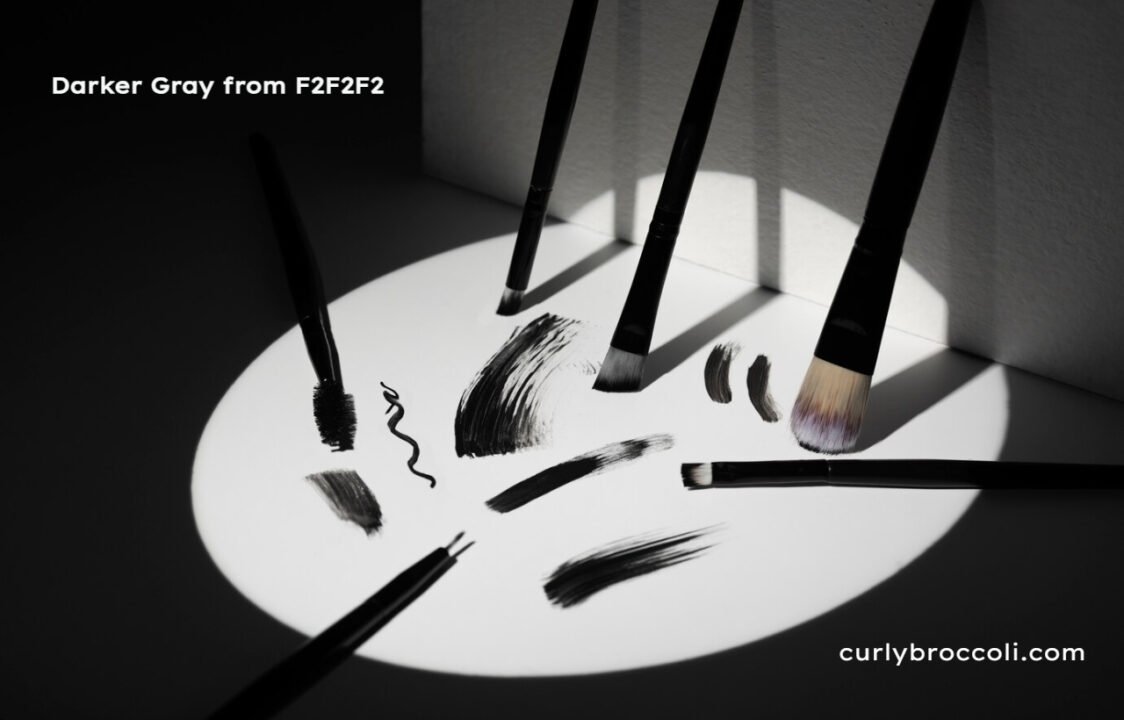When working with digital design, achieving the perfect shade of gray can seem surprisingly complex. Gray tones are essential in web and graphic design, often used as neutral backgrounds or to create subtle contrasts without overwhelming color. The color code F2F2F2, a light and soft gray, is commonly used but may need adjustments for deeper, more noticeable gray tones. This article explores how to create a darker gray from F2F2F2. Covering everything from color theory principles to practical adjustments, ensuring your designs always capture the exact shade you envision.
Understanding the Importance of Gray in Design
Gray serves as a foundational color in many design projects. Being neutral, it offers flexibility by pairing seamlessly with almost any color palette, making it ideal for websites, logos, and print materials. Often, designers start with lighter grays like F2F2F2 and then move toward darker shades to enhance specific elements within a composition. The balance and subtlety of gray help convey a polished, professional look that is invaluable in branding and user experience.
Gray tones also communicate particular emotions, with lighter grays like F2F2F2 suggesting calm and elegance, while darker grays add depth, mystery, and sophistication. This progression from F2F2F2 to a darker gray can be an art form in itself, involving both creativity and a fundamental understanding of color grading.
Basics of Color Code F2F2F2 in Digital Spaces
The color code F2F2F2 represents a very light, almost silver-toned gray with minimal contrast. It is a hexadecimal color code used in web design, where each pair of characters represents a level of red, green, and blue (RGB). With RGB values of (242, 242, 242), F2F2F2 sits close to white and is often chosen for its soft and subtle appearance. However, to achieve darker gray from F2F2F2, adjustments must be made within the RGB values to introduce more depth without losing the foundational balance of the original shade.
Methods to Create a Darker Gray from F2F2F2
Several methods can be employed to darken the F2F2F2 shade effectively. By adjusting the RGB values, blending with other colors, or utilizing CSS properties like opacity, designers can achieve subtle, nuanced darker grays.
1. Adjusting RGB Values
To darken F2F2F2, the RGB values should be lowered. For instance:
- Original F2F2F2 RGB Values: (242, 242, 242)
- Darker Adjustment: (200, 200, 200)
This adjustment decreases the brightness while retaining the proportional values, which keeps the color looking gray rather than shifting it towards another hue.
2. Blending with Black
Blending F2F2F2 with black allows for a gradual darkening effect. This can be achieved by overlaying black at low opacity levels over F2F2F2 or by combining it with darker hex codes.
For example:
- Blending F2F2F2 (RGB: 242, 242, 242) with a 5% black overlay darkens it slightly without affecting the gray tone.
- Using CSS, this effect can be replicated with a gradient or overlay.
3. Adding Color Filters in CSS
In web design, color filters allow precise adjustments without altering the original color code in the HTML. CSS properties such as filter: brightness(0.9); or filter: grayscale(1); can darken the color by controlling light exposure, creating a deeper gray while keeping F2F2F2 as the core color.
Practical Applications of Darker Grays from F2F2F2
Darker gray shades derived from F2F2F2 can be used strategically to create visual interest and functional design. Here are common applications:
Text and Background Contrast
Using a darker gray for text on a lighter background enhances readability without the stark contrast of black text on white. This approach is frequently seen in web design, where a shade between F2F2F2 and black is chosen to be easy on the eyes, especially in sections with extensive text content.
Shadow and Depth Effects
Adding darker grays to create shadows or depth within a design makes elements appear more three-dimensional. For instance, shadow effects behind buttons, menus, or images give the illusion of elevation, helping guide user interaction effectively.
Borders and Frames
Darker gray borders add subtle definition without overpowering the elements. By placing a darker gray frame around sections with F2F2F2 backgrounds, designers can delineate spaces effectively and maintain cohesion across the layout.
Choosing the Right Shades of Darker Gray
When selecting a darker shade from F2F2F2, the goal is to enhance but not overwhelm. Each increment darker can be visualized as a gradual progression:
- Hex #D9D9D9: A light-to-mid-gray that’s noticeably darker than F2F2F2, suitable for large text or background elements.
- Hex #BFBFBF: Mid-gray for medium contrast elements like subheadings or icons.
- Hex #999999: A deeper gray ideal for accents, dividers, or secondary text.
This incremental adjustment allows designers to experiment without drastic color shifts, ensuring that the selected darker gray remains consistent with F2F2F2’s visual language.
Tools to Help Darken F2F2F2 Easily
Various design tools facilitate the process of creating a darker gray from F2F2F2, making it easy to visualize and apply in projects.
1. Adobe Color and Photoshop
Adobe’s tools, including Photoshop, allow you to use sliders to darken the RGB values of F2F2F2 precisely. By adjusting the brightness and contrast, you can preview how different shades work within your layout before committing.
2. Online Color Pickers and Calculators
Sites like ColorHexa and Coolors provide quick options for adjusting F2F2F2 to darker variations. These tools offer hex, RGB, and HSL conversions, ensuring that the darker shade maintains the right balance.
3. CSS Variables for Dynamic Darkening
For web developers, CSS variables can control color across an entire site. By setting F2F2F2 as a base variable, you can define darker shades dynamically, which allows for easy customization and consistency across the design.
Design Tips for Working with Gray Tones
Grays should be used mindfully in design, as they carry significant visual and emotional implications. Here are some design tips when working with gray tones:
- Maintain Balance: Use darker grays sparingly against light grays to avoid creating a monochrome look that feels dull.
- Leverage Texture and Pattern: Adding texture to gray backgrounds can prevent them from appearing flat.
- Consider Color Psychology: Grays can convey calm and professionalism, so darker grays might be suitable for formal contexts or minimalist designs.
Darker Gray from F2F2F2 in UI/UX Design
In user interface (UI) and user experience (UX) design, gray tones are widely used due to their neutral, non-distracting nature. They allow primary colors to stand out while ensuring accessibility and readability. F2F2F2 and its darker counterparts work particularly well in these areas:
- Button Backgrounds: Darker grays derived from F2F2F2 make for effective button backgrounds in a monochromatic palette.
- Navigation Bars: Dark grays offer contrast in navigation areas without creating harsh breaks in the layout.
- Status Indicators: Darker shades of gray for inactive icons or indicators help users differentiate between active and inactive states visually.
Conclusion: Mastering the Darker Gray from F2F2F2 for Versatile Design
Darker gray from F2F2F2 offers a world of versatility for designers seeking balanced, aesthetically pleasing color palettes. By adjusting the RGB values, blending with black, or applying CSS filters, designers can achieve the ideal shade to match their project requirements. Whether for UI/UX design, web development, or graphic art. Understanding how to work with gray shades enhances your ability to create refined, professional compositions. Experimentation is key, and with the right tools, achieving the perfect darker gray from F2F2F2 becomes a rewarding part of the design journey.





